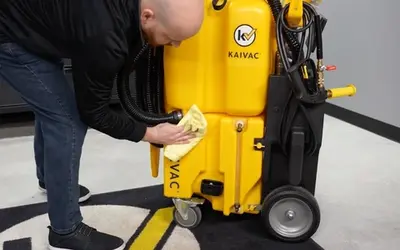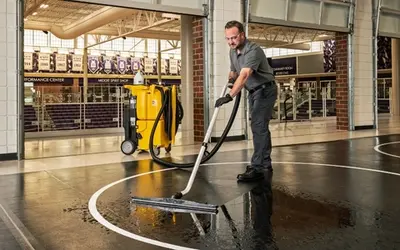How to Create a Cleaning Checklist

Knowing how to create a cleaning checklist makes the difference between employee success and failure. A well-designed cleaning checklist; complete with cleaning tasks, frequencies, tools, chemicals, and workflow expectations; removes guesswork and empowers workers.
But don’t just grab a checklist off the internet, print it out, and call it done.
While plenty of boiler plate options exist, knowing how to create a cleaning checklist that is customized and specific to the facility benefits everyone. Yes, your workers will know exactly what it expected of them on a daily, weekly, and monthly basis. But just as importantly, you will be armed with accurate, trackable data about what it takes to deliver a clean, healthy facility.
The late John Walker of ManageMen, outlined why data like this is so powerful. In an article for Facility Cleaning Decisions, Walker wrote that collecting this information empowers you to:
- Calculate productivity accurately
- Evaluate new tools and equipment
- Assess potential changes in cleaning frequencies or methods
- Have meaningful discussions with bosses and peers
Can all this come from a humble checklist? Yes, but it requires an initial investment of time and effort. Here’s how to create a cleaning checklist powerful enough to assess your facility, cleaning process, and tools while still guiding your staff to success.
Identify Cleaning Tasks and Times
Start customizing your cleaning checklist by identifying and logging every maintenance task currently performed in the facility. You can break tasks into three categories like daily, detail, and project. In a recent LinkedIn article Allen Randolph, VP Business Development at Kaivac, suggests starting with the big bucket items: restrooms, entryways, above the floor cleaning, floor care, trash, and utility work.
Then determine the time it takes to complete these tasks. Calculating cleaning times, also known as production rates, can be complicated but help is available. Seek out resources like The Official ISSA Cleaning Times: The Cleaning Industry’s Most Trusted Tasks, Tools & Workloading Resource that log tasks, the tools required to complete that task, and how much time the job should take using the chosen tool.
Customize Your Cleaning Tasks
Now it’s time to customize these production rates to your specific facility. Don’t just use the facility’s gross square footage as that will skew the data. Instead look at specifics like cleanable square footage, the size of restrooms, and number of fixtures.
Randolph states that this is also the time to start thinking about barriers your cleaning crew may face and how to overcome them. For instance, do they clean while the building is occupied? If so are there slip and trip hazards that can be removed?
Examine Workflow to Deliver the Best Clean
Knowing how to create a cleaning checklist means knowing the right workflow to complete the job. Workflow is a standardized, repeatable, trackable pattern that allows employees to finish the job with the least number of steps. Include workflow in a cleaning checklist to create a complete document that insures reliable, consistent results.
No matter your facility’s individual needs, some basic rules apply to workflow planning. For example, when cleaning restrooms, look to this article in American School & University Magazine for ideas. It lays out fundamentals like always cleaning from top to bottom, always cleaning from dry spaces to wet, and always putting out the “Wet Floor” sign.
Adding in the correct chemicals to use and their dwell times goes one step further in turning your cleaning checklist into a comprehensive, custom document.
How a Cleaning Checklist Can Optimize Investments
With production rates and a comprehensive cleaning checklist in hand, you can now assess your cleaning staff’s successes and where they could use some help. If your calculations show that those projects are taking too much time, reconsider your tool choice.
Cleaning large, hard-surface floors with a mop, for example, will eat up a ton of worker time. Arm your employees with better, faster technology, like an AutoVac Stretch™ from Kaivac instead and watch production rates shrink.
The same goes for hand cleaning restrooms. Not only is that task unpleasant, awkward, and physically demanding, it is also incredibly inefficient. ISSA estimates that it takes an average of three minutes to clean a single restroom fixture by hand. A No-Touch Cleaning® system from Kaivac cuts that time down to one minute per fixture. The tool will also clean and dry a floor much faster and more completely than any mop.
Knowing how to create a cleaning checklist takes a lot of effort at first but pays off in the end. Click here to learn more about time-saving cleaning solutions for every environment in your facility.
Related Posts

Preventive Maintenance for Your No-Touch Cleaning® System
Your Kaivac No-Touch Cleaning system makes restroom maintenance fast and easy. Keeping your No-Touch Cleaning system in good working order is also fast and easy. Kaivac makes performing preventative maintenance and troubleshooting potential issues simple. No special equipment or technical expertise required.
Read more
A Cleaning Lesson from Schools and Universities that Rely on Kaivac Systems
School, college, and university facilities departments from around the country love their Kaivac Cleaning Systems. Why wouldn’t they? Designed with the custodial worker in mind, these tools and processes from Kaivac are easy to master, work super-fast, and deliver exceptionally clean, fresh-smelling spaces.
Read more
Reduce Absenteeism Through Better School Cleaning
K-12 school leaders are coming up with a variety of ways to combat chronic absenteeism. Strategies like offering in-school laundry services and basic health care show a lot of promise. But providing better cleaning may be one of the most effective, most cost-efficient tactics available.
Read more